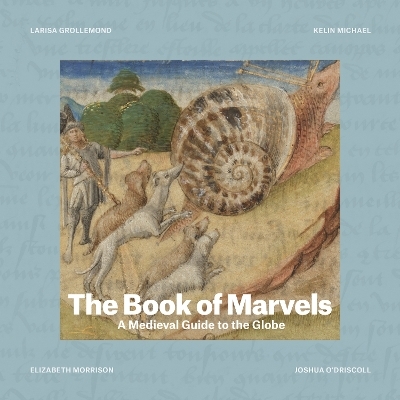
The Book of Marvels
A Medieval Guide to the Globe
Seiten
2024
J. Paul Getty Museum (Verlag)
978-1-60606-903-5 (ISBN)
J. Paul Getty Museum (Verlag)
978-1-60606-903-5 (ISBN)
This fascinating volume explores an important fifteenth-century illustrated manuscript tradition that provides a revealing glimpse of how Western Europeans conceptualized the world.
From the classical encyclopedias of Pliny to famous tales such as The Travels of Marco Polo, historical travel writing has had a lasting impact, despite the fact that it was based on a curious mixture of truth, legend, and outright superstition. One foundational medieval source that expands on the ancient idea of the "wonders of the world" is the fifteenth-century French Book of the Marvels of the World, an illustrated guide to the globe filled with oddities, curiosities, and wonders-tales of fantasy and reality intended for the medieval armchair traveler. The fifty-six locales featured in the manuscript are presented in a manner that suggests authority and objectivity but are rife with stereotypes and mischaracterizations, meant to simultaneously instill a sense ofwonder and fear in readers.
In this volume, the authors explore the tradition of encyclopedias and travel writing, examining the various sources for geographic knowledge in the Middle Ages. They look closely at the manuscript copies of the French text and its complex images, delving into their origins, style, content, and meaning. Ultimately, this volume seeks to unpack how medieval white Christian Europeans saw their world and how the fear of difference-so pervasive in society today-is part of a long tradition stretching back millennia.
“Like the richly illuminated medieval travel guides it describes, this beautifully illustrated publication takes the reader-viewer on a journey to distant and exotic lands and, with great sensitivity, highlights fifteenth-century European reactions to human difference, fantastic animals, and unfamiliar cultural practices that they found both fascinating and disturbing. With engaging essays that situate these remarkable manuscripts in their broader historical, artistic, and ideological contexts, the authors invite us to consider them in relation to the long traditions of travel-writing and cultural stereotypes, and most importantly, remind us that ‘otherness’ is always in the eye of the beholder.”—Debra Higgs Strickland, Professor of Medieval Art History, University of Glasgow
From the classical encyclopedias of Pliny to famous tales such as The Travels of Marco Polo, historical travel writing has had a lasting impact, despite the fact that it was based on a curious mixture of truth, legend, and outright superstition. One foundational medieval source that expands on the ancient idea of the "wonders of the world" is the fifteenth-century French Book of the Marvels of the World, an illustrated guide to the globe filled with oddities, curiosities, and wonders-tales of fantasy and reality intended for the medieval armchair traveler. The fifty-six locales featured in the manuscript are presented in a manner that suggests authority and objectivity but are rife with stereotypes and mischaracterizations, meant to simultaneously instill a sense ofwonder and fear in readers.
In this volume, the authors explore the tradition of encyclopedias and travel writing, examining the various sources for geographic knowledge in the Middle Ages. They look closely at the manuscript copies of the French text and its complex images, delving into their origins, style, content, and meaning. Ultimately, this volume seeks to unpack how medieval white Christian Europeans saw their world and how the fear of difference-so pervasive in society today-is part of a long tradition stretching back millennia.
“Like the richly illuminated medieval travel guides it describes, this beautifully illustrated publication takes the reader-viewer on a journey to distant and exotic lands and, with great sensitivity, highlights fifteenth-century European reactions to human difference, fantastic animals, and unfamiliar cultural practices that they found both fascinating and disturbing. With engaging essays that situate these remarkable manuscripts in their broader historical, artistic, and ideological contexts, the authors invite us to consider them in relation to the long traditions of travel-writing and cultural stereotypes, and most importantly, remind us that ‘otherness’ is always in the eye of the beholder.”—Debra Higgs Strickland, Professor of Medieval Art History, University of Glasgow
Larisa Grollemond is assistant curator of manuscripts at the J. Paul Getty Museum and was coauthor of The Fantasy of the Middle Ages (Getty, 2022) and a contributing editor for Book of Beasts: The Bestiary in the Medieval World (Getty, 2019). Kelin Michael was the 2021-22 graduate intern in the Department of Manuscripts at the J. Paul Getty Museum. Elizabeth Morrison is senior curator of manuscripts at the J. Paul Getty Museum and is a specialist in Flemish illumination. Joshua O'Driscoll is associate curator of medieval and Renaissance manuscripts at the Morgan Library & Museum.
| Erscheinungsdatum | 07.09.2024 |
|---|---|
| Zusatzinfo | 108 color and 23 black and white illustrations |
| Verlagsort | Santa Monica CA |
| Sprache | englisch |
| Maße | 254 x 254 mm |
| Themenwelt | Kunst / Musik / Theater ► Kunstgeschichte / Kunststile |
| Geschichte ► Allgemeine Geschichte ► Mittelalter | |
| Geisteswissenschaften ► Geschichte ► Regional- / Ländergeschichte | |
| ISBN-10 | 1-60606-903-9 / 1606069039 |
| ISBN-13 | 978-1-60606-903-5 / 9781606069035 |
| Zustand | Neuware |
| Informationen gemäß Produktsicherheitsverordnung (GPSR) | |
| Haben Sie eine Frage zum Produkt? |
Mehr entdecken
aus dem Bereich
aus dem Bereich
eine neue Geschichte des Mittelalters
Buch | Hardcover (2023)
C.H.Beck (Verlag)
38,00 €


